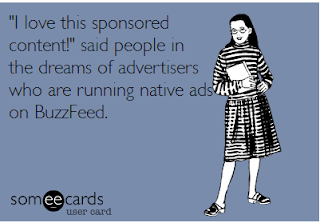kt202110@ohio.edu
Advertising agencies are always looking for the next best thing to get their product or client noticed or talked about. The age of the billboard is no more. Now, advertisers are taking on the guise of journalist as they promote their product in what is called "sponsored content" or "native advertising." For example, you are scrolling down The Huffington Post home page and you come across an article titled "8 Creative Ways to Use Crescent Rolls." What would you think if you found out that this article was sponsored by Pillsbury? This is sponsored content and this is the future of advertising.
 |
| An example of native advertising on BuzzFeed |
Some may say that the above example is deceitful. What -- you mean you didn't look close enough to see the small print at the end of the article that read sponsored content? If a publisher follows the PRSA guidelines for dealing with branded content, they can avoid deceit in their publication although the reader may still see it as such. PRSA requires disclosure that it is branded content and the allowance of all reader comments both positive and negative, among other requirements. Brands and advertisers could also be commended for creativity by placing their products in the minds of readers without them realizing that it is deliberately being promoted.
Smarter advertisers, smarter consumers
Consumers have gotten bored with advertisements, automatically blocking them out in magazines and pushing mute on the television during commercials. Before sponsored content it would seem that the consumers had outsmarted the advertisers. However, with the new age of branded content, consumers will have to step up their game again to notice the difference between native advertising and straight-forward content.
Native ads killed the newspaper star
I've mentioned how native advertisements can affect the relationship between consumers and advertisers, but what about the relationship between consumers and journalists? David Carr of The New York Times said that storytelling ads may be journalism's new peril. He explains it as "advertising wearing the uniform of journalism, mimicking the storytelling aesthetic of the host site."
The issue here is when publishers allow PR or advertising agencies direct access to the content management system so they can upload the sponsored content themselves. If these ads confuse enough readers who are unsure of whether the article was written by the host site or an outside PR agency, the host site and its journalist can lose credibility with the reader. People gravitate toward content they trust and native ads threaten the publications in which they provide sponsorship.
A way to avoid this impending doom for journalists is to have publishers ensure that advertisements do not mingle with content unrestricted. If this trend begins of not distinguishing between journalism and advertisements, a very slippery slope is in our future.


No comments:
Post a Comment